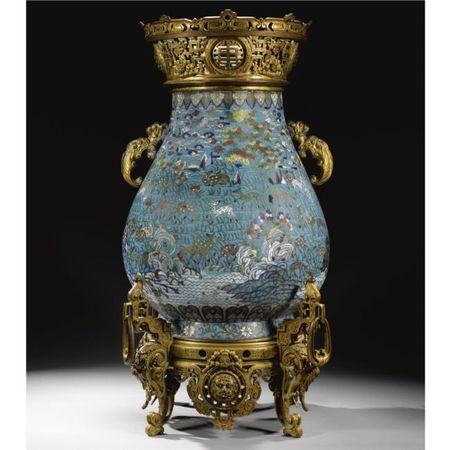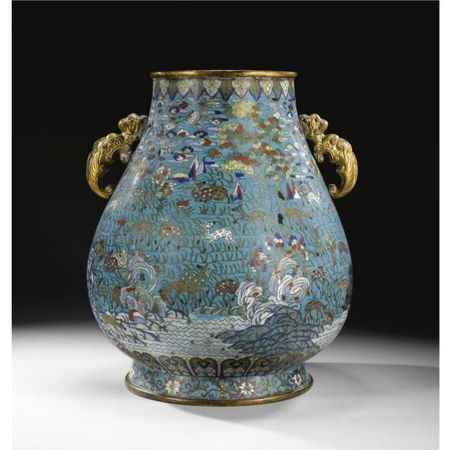A rare gilt-bronze mounted cloisonné enamel 'hundred deer ' vase; the vase Qing dynasty, Qianlong period, the mounts later
A rare gilt-bronze mounted cloisonné enamel 'hundred deer' vase; the vase Qing dynasty, Qianlong period, the mounts later
the pear-shaped body rising from a short spreading foot to an everted gilt rim, brightly decorated around the exterior with deer in a rocky landscape with cranes flying amidst ruyi-head cloud scrolls overhead, the shoulder set with a pair of gilt-copper dragon handles, the elaborate gilt-bronze mounts cast and pierced with lion masks to the base and shou characters to the rim. 79cm., 31 1/8 in. (including stand). Est. 30,000—40,000 GBP
NOTE: Cloisonné vases of this well-known 'Hundred Deer' design are rare, although a related piece was sold in these rooms, 16th November 1976, lot 52. Compare also examples of this form and design, but with varying decorative bands on the rim and foot; such as a pair of vases sold in these rooms, 7th November 2007, lot 447; a single vase sold at Christie's New York, 19th September 2006, lot 111; and another example sold at Christie's London, 6th November 2007, lot 97.
This vase in its shape and exquisitely composed design compares closely with the 'famille-rose' 'Hundred Deer' vases that are found in many major museums and private collections: see examples from the Qing Court collection, and still in Beijing, illustrated in The Complete Collection of Treasures of the Palace Museum: Porcelains with Cloisonné Enamel Decoration and Famille Rose Decoration, Hong Kong, 1999, pl. 85; and a pair and a single vase, in the Shanghai Museum, included in Selected Ceramics from the Collection of Mr. and Mrs. J.M. Hu, Shanghai, 1989, pl. 67, and in Chugoku toji zenshu, vol. 21, Kyoto, 1981, pl. 190.
The deer symbolises immortality and is the companion of Shoulao, the God of Longevity. As the word deer in Chinese, 'lu', is the homophone for the word 'official salary', they also represent wealth and are associated with official and scholarly success. Thus, the 'Hundred Deer' design conveys the wish for great wealth and success. It also represents filial piety, which comes from the folk tale of Zhou Yanzi, the story of a young boy who tries to get milk from a deer to cure his ailing father by wearing deer skin and joining a deer herd.
Sotheby's. Fine Chinese Ceramics & Works of Art. 13 May 09. London www.sothebys.com photo courtesy Sotheby's.

/https%3A%2F%2Fprofilepics.canalblog.com%2Fprofilepics%2F1%2F0%2F100183.jpg)
/https%3A%2F%2Fstorage.canalblog.com%2F03%2F02%2F119589%2F96711876_o.jpg)
/https%3A%2F%2Fstorage.canalblog.com%2F11%2F31%2F119589%2F94773502_o.jpg)
/https%3A%2F%2Fstorage.canalblog.com%2F20%2F83%2F119589%2F94772815_o.jpg)
/https%3A%2F%2Fstorage.canalblog.com%2F26%2F72%2F119589%2F75604929_o.jpg)
/https%3A%2F%2Fstorage.canalblog.com%2F59%2F60%2F119589%2F26458628_o.jpg)




/http%3A%2F%2Fstorage.canalblog.com%2F98%2F98%2F119589%2F129097971_o.jpg)
/http%3A%2F%2Fstorage.canalblog.com%2F93%2F75%2F119589%2F128489120_o.jpg)
/http%3A%2F%2Fstorage.canalblog.com%2F09%2F29%2F119589%2F128488304_o.jpg)
/http%3A%2F%2Fstorage.canalblog.com%2F62%2F18%2F119589%2F128488091_o.jpg)